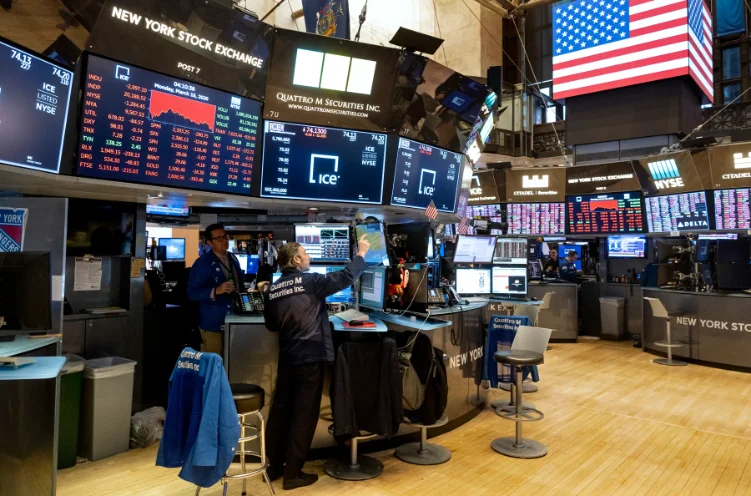On Friday, the global stock market had a tough time, even though big tech companies tried to give it a boost. Meanwhile, the interest rates for government bonds and the value of the dollar didn’t change much. This happened as new data confirmed that inflation in the United States is still high, but it’s not worse than what experts expected.
A report from the U.S. Commerce Department revealed that the rise in prices, which is a part of inflation, was mostly because of housing costs. However, it looks like people are slowing down their spending in early 2024. Most economists think that the Federal Reserve won’t increase interest rates anymore, but there’s still a chance they might change their minds and do it.
Jeffrey Roach, who is the chief economist at LPL Financial in Charlotte, North Carolina, said in an email that, “This report is unlikely to make the Fed change its belief that inflation will decrease in the upcoming months as demand slows.”
The Dow Jones Industrial Average fell by 1.12%, the S&P 500 went down by 0.48%, and the Nasdaq Composite increased by 0.38%.
Amazon.com saw its stock rise by almost 7% after surpassing sales expectations. Meanwhile, Intel’s stock jumped by over 9% because the chipmaker signaled that the personal computer market is getting better after several months of decline. On the other hand, Chevron’s stock fell by 6.7% after the major oil company reported a decrease in third-quarter profits.
The global stock market index, MSCI, dropped by 0.22%. This decrease came after some positive news on Thursday, when it was revealed that the U.S. economy had its fastest growth in nearly two years in the third quarter. Additionally, the European Central Bank (ECB) decided to keep interest rates steady.
On Friday, European stocks fell to their lowest point in nearly seven months and marked a second week of losses. Among them, France’s top stock index saw the biggest decline because Sanofi, a major pharmaceutical company, withdrew its profit forecast for 2025.
In the Asia-Pacific region, things looked a bit better as MSCI’s broadest index rose by about 1%, recovering from an 11-month low it hit on Thursday.
Gentle Landing?
The yield on the 10-year U.S. Treasury, which is a measure of how much the government has to pay to borrow money, didn’t change much and stood at 4.837%. This yield is essential for determining global borrowing costs, and it had briefly gone above 5% earlier in the week.
According to strategists at Bank of America, even though the U.S. economy showed unexpectedly strong growth in the third quarter, a slowdown in the fourth quarter makes it more likely that we’ll have a gentle economic slowdown, rather than a sudden and harsh one.
On a global scale, they mentioned in a note on Friday that “markets are still hoping that prices will rise more slowly, but we shouldn’t take that for granted.”
The Federal Reserve (often referred to as the Fed) is expected to keep its interest rates in the range of 5.25% to 5.5% in the coming week. However, Jay Powell, who is the chair of the Fed, has mentioned that if the economy stays strong and jobs remain scarce, there might be more interest rate increases in the future.
The European Central Bank (ECB) decided to keep its deposit rate at a historically high 4% on Thursday. However, their President, Christine Lagarde, hinted that they might consider making money less available in the future, which could mean higher interest rates.
Oil prices went up because investors became worried about a possible increase in conflict in the Middle East. This kind of conflict could disrupt the supply of oil. Israeli military forces are intensifying their operations in the Gaza Strip, and there have been reports of heavy airstrikes in that area.
The price of U.S. crude oil went up by 2.33% to reach $85.15 per barrel, and Brent crude was at $90.12, which is an increase of 2.49% in a single day.
The price of spot gold increased by 1.1% to $2,005.78 per ounce.
Fluctuations in Currency
In the world of currency exchange, the euro remained stable at $1.056 per dollar, but it’s worth noting that it has dropped by nearly 14% over the past three months.
The value of the U.S. dollar has been on the rise, going up by almost 5% in the last three months. This increase is because of higher interest rates and the strong U.S. economy. It’s also on track for a weekly gain, even though it didn’t change much on the day.
The Japanese yen reached a new low against the dollar, hitting 150.77 yen per dollar overnight. Currently, it’s at 149.59 yen per dollar. This is not far from the three-decade low of 151.94 yen per dollar that was reached in October last year. To stabilize its currency, Japanese authorities had to step in and take action back then.





